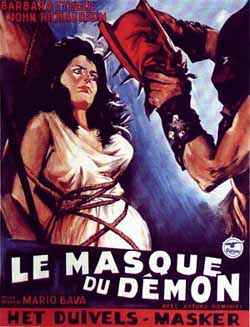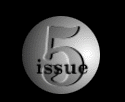|
This sequence from Mario Bava's Black Sunday (La Maschera del Demonio, 1960) illustrates the expressive power of his directoral style. The scope and invention of his visual scheme create a Baroque atmosphere which is both evocative in its own right and entirely appropriate to the characters and subjects of the horror genre. Coleridge described stylistic invention in Biographia Literaria as a process which "dissolves, diffuses, and dissipates...is essentially vital, even as all objects [as objects] are essentially fixed and dead." For many filmmakers the "fixed and dead" objects are the conventions of the genre. In a vampire film, the cobwebs, the creaking doors, the rubber bats flapping their wings at the end of all-too-visible strings can be suffocating restrictions and overused to the point of becoming laughable clichés. Bava's tactic was a reliance on fresh rendering or novel manipulation of traditional images. The intricate series of dissolves in Black Sunday through which a skull re-acquires flesh implies an unseen energy. Details are added to help externalize the metaphysical reality of the moment. As each layer of skin reappears, the punctures in the face left by the demon's mask close into fine circles then recede altogether. The black, empty sockets slowly refill to disclose the whites of eyes enraged by centuries of death. Finally the nostrils flare, the neck constricts, and the whole body arches up under the sting of renewed life. This new vitality--and the simultaneous apprehension which the sequence engenders in the viewer--builds to a point at which it can no longer be contained and the stone itself must rupture to release it.

Belgian poster artwork for Black Sunday
courtesy of Dean Harris and Silent Scream.
The unusual and disquieting visuals of Bava's films seem rooted in a conception of life as an uncomfortable union of illusion and reality. The dramatic conflict for his characters lies in confronting the dilemma of distinguishing between the two perceptions. In the black-and-white Black Sunday, Bava captured the apprehension of a figure moving down a corridor by a device as simple as a shifting sidelight. As this light strikes first one half of the face and then the other, it is easy to equate with the mixture of fear and curiosity that drives the character forward. In his later color films, Bava frequently compounded this equation by changing the light from blue to red with their respective connotations of cold and warmth.
While the plot lines of Bava’s movies often contain the presence of an extraordinary being or object in an otherwise natural environment, that is seldom the narrative focus. Instead Bava led his central figures out of their normal lives into a world of lurking phantoms or psychopaths. With allusions that ranged from Dante to Hitchcock--the Italian title of the suspense-comedy, The Evil Eye is La Ragazza che sapeva troppo or The Girl Who Knew Too Much--Bava situated his protagonists in a mutable world, composed of opposing spheres of influence, of shifting colors and times, of complements and atonalities. This world moves, like Spenser’s ever-whirling wheel from reality to illusion and back again, from life to death and death to life through a landscape littered with phantasmagorical sights and sounds. On both symbolic and sensory levels, Bava’s dramatic personae are thrust into the unstable middle ground between these two existential extremities, where figures glide through misty, opulently decorated but ultimately illusory and insubstantial settings. This spectral passageway linking the natural and supernatural worlds was, for Bava, a world of semi-darkness in which shadows and hallucinations can be real and, more importantly, in which the path forward or back, the way out, is unmarked.
See the oracle Medea,
an excerpt from Hercules in the Haunted World.
(Animated GIF, 7 frames, 76 KB)
The oracle Medea in Hercules in the Haunted World (Ercole al Centro della Terra, 1961) typifies one stranded in this limbo. The masked form of the woman is combined with an eerie, labored voice, modulated as if she were calling from a chamber deep below ground. She is separated from the camera, or real world, plane of view by a curtain of glimmering beads. While she sits swaying between two worlds, a series of green, blue, and gold lights successively cut through the frame, alternately striking her body and falling behind her to throw her into silhouette.
page 1 of 4
 
Italian Horror Menu page
Italian Horror: A Brief Introduction
Mario Bava: The Illusion of Reality
Mario Bava's Rabid Dogs
Mario Bava Biography
The Horrible Dr. Hichcock
The Devil's Commandment 
Castle of Blood 
Nightmare Castle
The Bloody Pit of Horror 
Italian Horror in the Seventies
Suspiria
Italian Horror Web Links
Photo credits: Dean Harris, Silent Scream, and Sinister Cinema.
|





